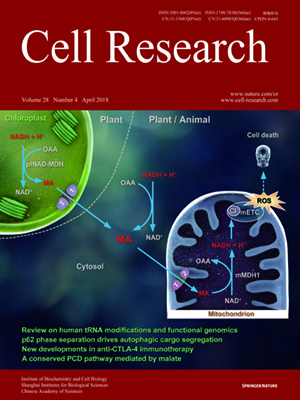
Volume 28, No 4, Apr 2018
ISSN: 1001-0602
EISSN: 1748-7838 2018
impact factor 17.848*
(Clarivate Analytics, 2019)
Volume 28 Issue 4, April 2018: 448-461 | Open Access
ORIGINAL ARTICLES
Malate transported from chloroplast to mitochondrion triggers production of ROS and PCD in Arabidopsis thaliana
Yannan Zhao 1,2, Lilan Luo 1, Jiesi Xu 3, Peiyong Xin 1, Hongyan Guo 1
, Jian Wu 1,4, Lin Bai 1,2, Guodong Wang 1, Jinfang Chu 1,Jianru Zuo 1,2, Hong Yu 1, Xun Huang 2,3 and Jiayang Li 1,2,
1State Key Laboratory of Plant Genomics and National Center for Plant Gene Research, Institute of Genetics and Developmental Biology, Chinese Academy of Sciences, Beijing 100101, China; 2University of Chinese Academy of Sciences, Beijing 100049, China and 3State Key Laboratory of Molecular Developmental Biology, Institute of Genetics and
Developmental Biology, Chinese Academy of Sciences, Beijing 100101, China
Correspondence: Hong Yu (hyu@genetics.ac.cn) or Xun Huang (xhuang@genetics.ac.cn) or Jiayang Li (jyli@genetics.ac.cn)
Programmed cell death (PCD) is a fundamental biological process. Deficiency in MOSAIC DEATH 1 (MOD1), a plastid-localized enoyl-ACP reductase, leads to the accumulation of reactive oxygen species (ROS) and PCD, which can be suppressed by mitochondrial complex I mutations, indicating a signal from chloroplasts to mitochondria. However, this signal remains to be elucidated. In this study, through cloning and analyzing a series of mod1 suppressors, we reveal a comprehensive organelle communication pathway that regulates the generation of mitochondrial ROS and triggers PCD. We show that mutations in PLASTIDIAL NAD-DEPENDENT MALATE DEHYDROGENASE (plNAD-MDH), chloroplastic DICARBOXYLATE TRANSPORTER 1 (DiT1) and MITOCHONDRIAL MALATE DEHYDROGENASE 1 (mMDH1) can each rescue the ROS accumulation and PCD phenotypes in mod1, demonstrating a direct communication from chloroplasts to mitochondria via the malate shuttle. Further studies demonstrate that these elements play critical roles in the redox homeostasis and plant growth under different photoperiod conditions. Moreover, we reveal that the ROS level and PCD are significantly increased in malate-treated HeLa cells, which can be dramatically attenuated by knockdown of the human gene MDH2, an ortholog of Arabidopsis mMDH1. These results uncover a conserved malate-induced PCD pathway in plant and animal systems, revolutionizing our understanding of the communication between organelles.
10.1038/s41422-018-0024-8
FULL TEXT | PDF
Browse 1793


